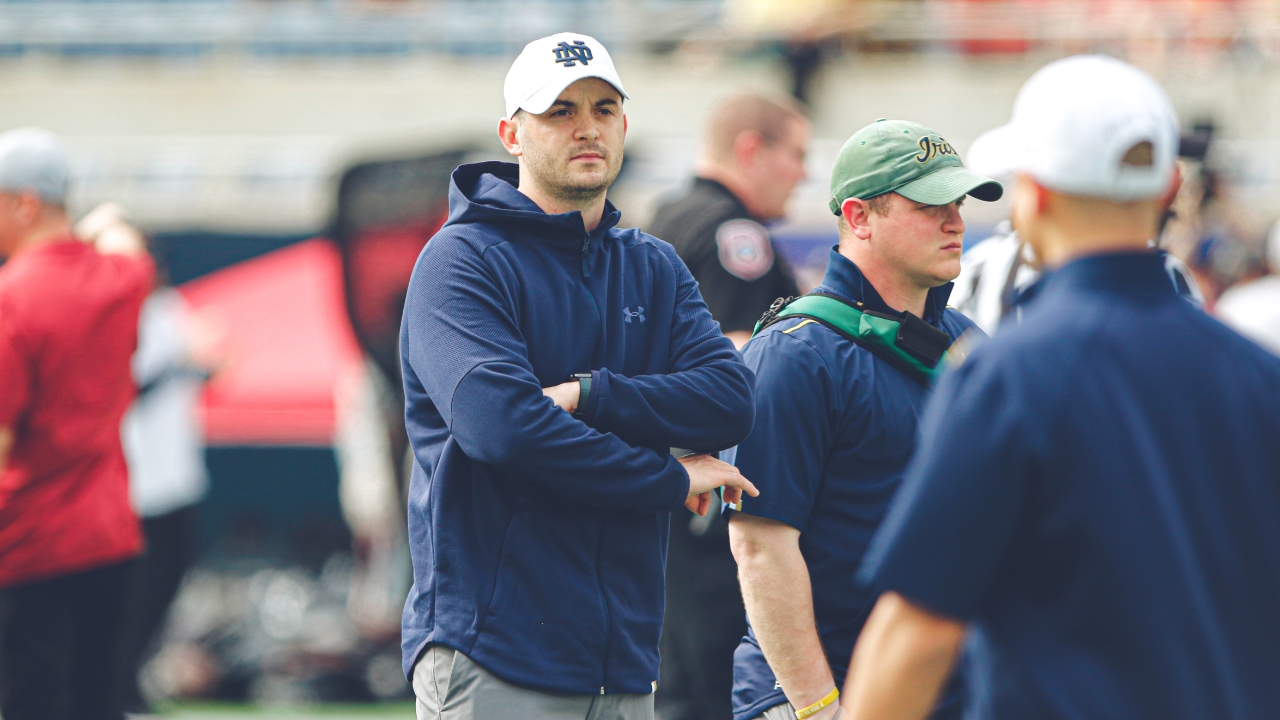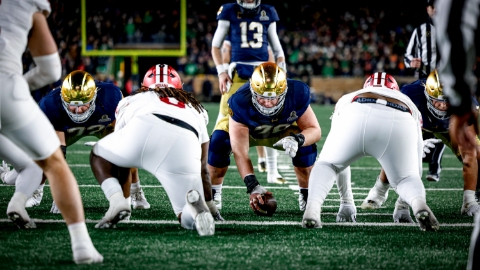
Last year Notre Dame had a top-3 offensive line, a deep tight end group, a great running back, an athletic dual-threat at quarterback, and two senior receivers who aren’t going to get drafted by the NFL. That personnel helped shape who Notre Dame was on offense in Tommy Rees’ first season as offensive coordinator.
This year is going to be a lot different.
There will be four new starters on the O-line, a loaded backfield, what should be a healthy wide receiver group, a rising star at tight end, and a new quarterback. To say the identity on offense is likely to change is an understatement.
There’s a lot of directions the offense could go in 2021. Some of it might be philosophical with an increase in RPOs and play-action passing. So much of it will be dictated by the personnel.
Here’s a look at each position group on offense and how they could impact a change in offensive identity this season.
New faces on the O-line
It’s reasonable to suggest that Tommy Rees won’t be able to lean on the running game as much as he did last season with the changes in personnel. Replacing that many offensive linemen will make it tough to duplicate the same kind of blocking success. PFF graded the Irish offense second in the country in run blocking in 2020.
The 2020 Notre Dame running game was good. They were 26th in adjusted line yards, 30th in opportunity rate, and 15th in stuff rate. They averaged a solid 5.02 yards per carry.
The 2017 Notre Dame team, running behind a Joe Moore Award winning O-line, was fifth in adjusted line yards, 11th in opportunity rate (percentage of runs that gained at least five yards), and 22nd in stuff rate (runs tackled at or behind the line of scrimmage). Those rankings dropped to 106th, 112th, and 121st in 2018. Yards per carry dropped from 6.25 to 4.43.
The ‘18 offensive line got better as the season went on and protected well (16th in passing down sack rate), but it was a mistake to not lean into the passing game more that season. The Irish ran the ball 59.5% of the time in ‘17 and that number only dipped to 54.5% despite being significantly worse at running the ball.
We’ll see where things are at with four new starters on the offensive line this season, but if they run at the same rate they did in ‘20 (56.6%) and the O-line significantly drops off with their run blocking, that would be a mistake.
There’s no indication as to who the other starters will be and how things will be configured up front. It’s almost a certainty that the line will not be as good as it was in ‘20 with that many new players stepping up. The key will be evaluating how big the drop off might be and then adjusting to the offensive identity around that.
Replacing Tremble and Wright
Losing those two tight ends is something to monitor when it comes to effectiveness running the ball.
Tommy Tremble was a huge asset who could be used as a fullback, H-back, and in-line. If he wasn’t the best blocking tight end in the country, he was close. Brock Wright was also a very good in-line blocker. He was better than Cole Kmet, Nic Weishar, Alize Mack, and Durham Smythe so saying that he and Tremble will easily be replaced as run blockers isn’t something that should be taken for granted.
We know Michael Mayer is almost always going to be on the field. Can the next two tight ends, (from a group of George Takacs, Kevin Bauman, Cane Berrong, and Mitchell Evans) be as good blocking as Tremble and Wright? If the answer is no, then more 11 personnel will likely be the base package on offense for Notre Dame this season.
Finally time for more receivers?
Before we get into the current group, a reminder that Ben Skowronek and Javon McKinley were better blockers than most tight ends in college football. That’s one more piece to the offense potentially running less.
Moving on from that, Notre Dame is only running more 11 (or heaven forbid...10!?) if they feel better about the wide receiver position.
The good news is that Brian Kelly has already mentioned that Braden Lenzy and Lawrence Keys are having strong springs. We’ve seen plenty of receivers making plays on the highlights as well. And Kevin Austin isn’t even participating in spring while getting healthy. With Avery Davis leading the way as a veteran presence, the talent should be there for the offense to play with more receivers on the field more often.
The next part of that is what they’ll do with those receivers. Attacking vertically more should be in the cards. Finding more ways to take advantage of numbers on the perimeter for players like Davis and Keys to make plays after the catch should be a priority as well, especially if the offense is looking for ways to be productive without running the ball inside as much.
If the offense swings further toward athletes winning in space more, we may see another option.
More backs on the field
If we’re talking best 11 on offense, Kyren Williams and Chris Tyree would be in that group. Heck, C’Bo Flemister might be close to that as well. The backfield is a strength for Notre Dame, which makes it harder to get away from running the ball as much.
However, might we see two backs on the field more? Could Williams or Tyree split out and become more involved in the passing game? They combined for 12 catches against Alabama and while I don’t think we’ll see that many catches from them each week, there could be some weeks we see that kind of production. They both can make defenders miss and be dangerous after the catch.
Williams lined up in the slot on only 6.5% of passing plays last season. Tyree only lined up there on 4.3%.I would expect those numbers to go up in ’21.
New quarterback
What we know so far about the quarterback position is that it appears to be a two-man competition with Drew Pyne and Jack Coan vying for the job. Both are accurate passers who can win from the pocket. Both have been throwing the deep ball well in spring from what we have heard.
I don’t think it’s assuming too much that whoever is the quarterback can be better in the pocket than Book. It’s also fair to assume that neither Pyne or Coan will be as exceptional at improvising, whether that is scrambling or finding receivers on plays that are extended after escaping the rush. It would be surprising to me if Rees ran either of them as much as he ran Book on designed runs.
Pyne is a good athlete, but smaller and likely a notch below Book as a runner. I know there has been a lot of discussion about Coan being a better runner than he is given credit for because of his lacrosse background, but he averaged 3.8 yards per carry minus sack yardage at Wisconsin and only had three runs longer than 10 yards in 2019. He will not be a big part of the running game if he wins the starting job.
This offense is going to look different this fall. How different will largely be determined by how some position groups develop this spring, but it’s undeniable that Notre Dame lost several players who helped shape their offensive identity last season.
Now it’s time for some new players to step and help establish a new one.
